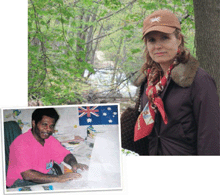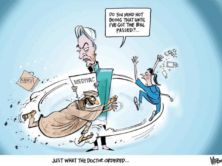
MURDER HE WROTE? Yours truly, Rhonda R. Shearer as depicted in Science magazine, alongside, former Papua New Guinea (PNG) World Wildlife Fund employee and indigenous person Daniel Wemp. Jared Diamond claims in his dramatic tale published by The New Yorker last year, that Wemp was a blood "thirsty" "killer" responsible for organizing "about 30 killings" during 1992-1995 -- an account for which Wemp served as his sole, unverified source.
This is #1 in a series of iMediaEthics blog posts that will respond to Jared Diamond’s and New Yorker’s exclusive statements to Science magazine, published May 15, 2009…
Judging by the quotations attributed to Jared Diamond in last week’s breakthrough news report in Science magazine, “‘Vengeance’ Bites Back At Jared Diamond,” denial is not just a river in Egypt.
Michael Balter, who scored the interview exclusives with both Diamond and New Yorker editor David Remnick, wrote that “Diamond insists that he followed good journalistic practice” when writing the now infamous April 21, 2008 essay “Annals of Anthropology: Vengeance Is Ours: What can tribal societies tell us about our need to get even?”
(Read the Associated Press report for a good summary of the controversy regarding the charges of inaccuracy by iMediaEthics and the Handa and Ombal tribesmen, Hup Daniel Wemp and Henep Isum Mandingo, who are now suing Diamond and The New Yorker for libel in the New York State Supreme Court).
Diamond’s primary source, Wemp, denies both the factual claims and quotations Diamond attributes to him. Even journalists reporting on far more trivial matters than capital crimes fastidiously corroborate their information: they call this fundamental practice the “two-source rule.”
The sad truth is, however, using one source to detail the unpublished history of Papua New Guinea tribal warfare when your source is not a historian but your paid employee/driver, is hardly “good practice” for a UCLA freshman, let alone a UCLA full professor and scientist with multiple awards.
Diamond told Balter (emphasis mine) that he “confirmed that some of the people Wemp named had been involved in a tribal war” with “some younger members of his [Wemp’s] tribe” but makes no mention of checking with these other Handa about other facts, such as numbers people killed, dates, tribal names or locations. (The lack of verification is why Diamond’s essay is riddled with errors, such as mistakenly referring to villages as tribes or calling Henep Isum Mandingo an Ombal when he is a Henep tribesmen. See our 10,000-word report on iMediaEthics).
“ ‘The complaint has no merit at all,’ Diamond told Balter who interviewed Diamond for Science in “his office at the University of California, Los Angeles, where he is a professor of geography.” The key defense for Diamond was that he took lots of “detailed notes” during the May 2006 interview that he had with Wemp. (The New Yorker fact checker, Chris Jennings, said these were the only notes provided by Diamond).
The Society of Professional Journalism’s (SPJ) Code of Ethics states: “Test the accuracy of information from all sources and exercise care to avoid inadvertent error.”
Reporting on a war requires, at the very least, testing facts with sources from both sides. Diamond admits, without apology, that he spoke only to Handas (Daniel and some unnamed “younger members” not sourced in the original New Yorker report) and no Ombals, who he wrongly describes as enemies of long standing.
The cardinal journalistic value cited in the SPJ code requires that all the indigenous individuals Diamond named as criminals be contacted before publication. The code states: “Diligently seek out subjects of news stories to give them the opportunity to respond to allegations of wrongdoing.”
Diamond told Balter that he left all that up to Wemp. And yet, Wemp had no idea, as Diamond himself admits, that there would be a New Yorker story naming him and others as being connected to heinous crimes.
Balter wrote that Diamond “did not try to get permission from [Isum] Mandingo and the others.” He quotes Diamond: “I trusted Daniel’s judgment about what was appropriate to discuss.” Diamond’s abdication of responsibility to contact people he plans to name as murderers and rapists is a clear departure from what he claims as his “good journalistic practice.”
Here are the quotations from Diamond’s piece, whose odd numbers suggest precision. Diamond writes in his New Yorker essay (emphasis mine) that “seventeen other men had been killed” in the years before the alleged 3-year war. He goes on the say “it took three years, twenty-nine more killings…before Daniel succeeded in discharging this responsibility.” Later he writes, “In total, about thirty people were killed in those six battles.” It all sounds so real. In fact, the use of odd numbers like 17 and 29 killed suggest a precision in the research. But the truth is that this “war” did not last three years and it did not involve six battles that killed 17 or 29 people. Four people were killed in three months of fighting in 1993. We verified these facts with dozens of people, including police, missionaries, tribal members (from both sides) and government officials.
The public deserves better than the illusion of exactness. The numbers of dead and all other facts—except the names of indigenous peoples—Diamond tells Balter are unverified.
Mako John Kuwimb who is both a Handa and Ombal, a lawyer and a PhD candidate in law at James Cook University, Queensland, Australia, sent Diamond and The New Yorker a detailed, 26-page report in response to the factual errors as well as the actual history of the sole Handa and Ombal dispute in 1993.
Bent but unbowed, Diamond bravely told Science magazine “that he still considers Wemp’s original account to be the most reliable source for what happened” even after Wemp and Kuwimb have informed him that all his facts are wrong except for people’s names.
Surely the public, the scientific and the UCLA community deserve better, and the tribes and tribesmen deserve retractions and apologies from Diamond and The New Yorker.
UPDATED 05/18/09: 10:51pm
UPDATED 05/20/09: 10:12am — Check out this blog post by a journalist who outlines the basic journalism standards he learned in J-School. Go to this very helpful context –what the blogger, Jeremy Porter, calls ” tried and true principles of journalism” for judging Diamond’s claim that he adhered to good journalism practice






